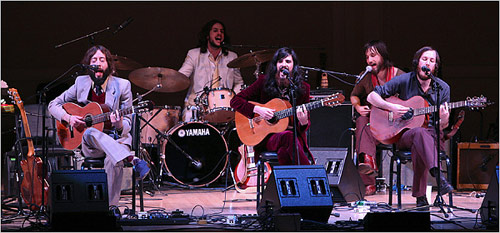
Carnegie Perspectives Series: Dreamland By Ben Ratliff
Friday night’s concert of new experimental folk music at Carnegie Hall was programmed by David Byrne. At the beginning, for three long minutes, Mr. Byrne stood onstage twitching, tripping on one-liners and looking in need of rescue. Discomfort is his trademark, but it still looked strange. Possible headlines for what followed: Unruly Beards at Carnegie Hall; Radical Acoustic Fringe Goes Legit; A Confirmation Ritual for “Freak Folk.” Please, no. Anyone who thinks this music hasn’t already been taken seriously in the last three years is mistaken. (Check Nexis, or take note that Isaac Stern Auditorium was packed to the high balconies, full of models and rock stars and people with money.) And here are two reasons not to call this loose movement by the aforesaid alliterative name. One: the musicians loathe it. Two: true freaks wouldn’t have been able to pull off what happened on Friday. Maybe Mr. Byrne was feeling superfluous. He picked the artists for the concert, called “Welcome to Dreamland” (part of his “Perspectives” series last week at Carnegie), but they had already picked one another. Devendra Banhart, who headlined, is the connector piece for a flock of performers and bands who have either sprung up since the turn of the century or been lovingly pried from late-1960s time capsules. And three of the five acts in Friday’s event had played a concert together last month in London, dry-running a cooperative system of sharing band members. Friday’s show used about 25 musicians working as a large cast, with instrumentation constantly changing. Amazingly, it worked; the show felt almost windborne. First was CocoRosie, with the sisters Sierra and Bianca Casady at the center of a fluctuating band. Bianca sings and raps in a pinched baby’s bark. Sierra sang in an operatic soprano. They were surrounded by piano, bass, two beatboxers using their voices to make rhythm, a harp (played by Sierra), and eventually a string trio. A color-saturated kiddie cartoon ran on a screen behind them. It was well performed, and pitched at an unbearable level of twinkly oddity. Next, Adem, — a k a Adam Ilhan, an English singer-songwriter — played harmonium, guitar, tiny bells and autoharp, and sang about comfort and humility and love on other planets. Sweet and earnest, with perfect diction, at a certain point his naïve metaphysics became too easy to mock. But again, it was immaculately arranged, sonically clear, fluctuating naturally from 7 musicians, to 11, to one. Vetiver played a beautiful set, the least mannered of all. Having worked as Mr. Banhart’s touring band, it keeps a traditional folk-rock foursome at its center. But it sounds refined: between Andy Cabic’s light, nasal voice, a little like Jerry Garcia’s, and Otto Hauser’s simple, lightweight drum grooves on songs like “I Know No Pardon,” the band put high musicality into easy-medium tempos. It’s already a good group and will no doubt get better. Some of Vetiver’s members helped the English alt-folk matriarch Vashti Bunyan in her set, as she spun her delicate narratives of motherhood, travel and animated spirits. Several of these bare-bones songs were more than 40 years old, and were made newly deluxe with tiny ministrations of xylophone, strings and antiphonal vocal arrangements around their composer, sitting at center stage with her guitar and singing just above a whisper. Finally came Mr. Banhart, who was happily complicated: he served as comic relief, loud contrast, an embodiment of the music’s stereotypes and an overturner of them. He sang a few acoustic songs, including “Long-Haired Child,” and a new one in Spanish about flags. He performed a song with lyrics that began, “I’m high and I’m happy and I’m free,” but assured the audience that the line was a joke. Then he strapped on an electric guitar and his quartet got loud and sloppy. At the conclusion, all hands reappeared onstage to sing a round by Moondog, another free spirit they claim as a forebear. “What are we doing here?” Mr. Banhart asked rhetorically at one point between songs. And the significance of the concert might have stopped at that easy remark. But they did it: they used tribal instincts to prove themselves a school. |




